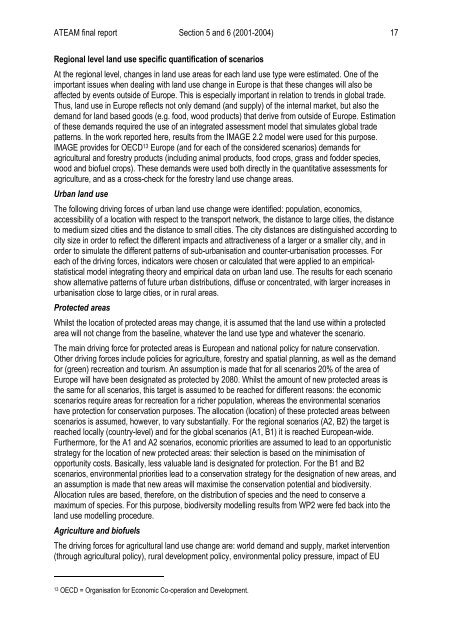ateam - Potsdam Institute for Climate Impact Research
ateam - Potsdam Institute for Climate Impact Research
ateam - Potsdam Institute for Climate Impact Research
Create successful ePaper yourself
Turn your PDF publications into a flip-book with our unique Google optimized e-Paper software.
ATEAM final report Section 5 and 6 (2001-2004) 17<br />
Regional level land use specific quantification of scenarios<br />
At the regional level, changes in land use areas <strong>for</strong> each land use type were estimated. One of the<br />
important issues when dealing with land use change in Europe is that these changes will also be<br />
affected by events outside of Europe. This is especially important in relation to trends in global trade.<br />
Thus, land use in Europe reflects not only demand (and supply) of the internal market, but also the<br />
demand <strong>for</strong> land based goods (e.g. food, wood products) that derive from outside of Europe. Estimation<br />
of these demands required the use of an integrated assessment model that simulates global trade<br />
patterns. In the work reported here, results from the IMAGE 2.2 model were used <strong>for</strong> this purpose.<br />
IMAGE provides <strong>for</strong> OECD 13 Europe (and <strong>for</strong> each of the considered scenarios) demands <strong>for</strong><br />
agricultural and <strong>for</strong>estry products (including animal products, food crops, grass and fodder species,<br />
wood and biofuel crops). These demands were used both directly in the quantitative assessments <strong>for</strong><br />
agriculture, and as a cross-check <strong>for</strong> the <strong>for</strong>estry land use change areas.<br />
Urban land use<br />
The following driving <strong>for</strong>ces of urban land use change were identified: population, economics,<br />
accessibility of a location with respect to the transport network, the distance to large cities, the distance<br />
to medium sized cities and the distance to small cities. The city distances are distinguished according to<br />
city size in order to reflect the different impacts and attractiveness of a larger or a smaller city, and in<br />
order to simulate the different patterns of sub-urbanisation and counter-urbanisation processes. For<br />
each of the driving <strong>for</strong>ces, indicators were chosen or calculated that were applied to an empiricalstatistical<br />
model integrating theory and empirical data on urban land use. The results <strong>for</strong> each scenario<br />
show alternative patterns of future urban distributions, diffuse or concentrated, with larger increases in<br />
urbanisation close to large cities, or in rural areas.<br />
Protected areas<br />
Whilst the location of protected areas may change, it is assumed that the land use within a protected<br />
area will not change from the baseline, whatever the land use type and whatever the scenario.<br />
The main driving <strong>for</strong>ce <strong>for</strong> protected areas is European and national policy <strong>for</strong> nature conservation.<br />
Other driving <strong>for</strong>ces include policies <strong>for</strong> agriculture, <strong>for</strong>estry and spatial planning, as well as the demand<br />
<strong>for</strong> (green) recreation and tourism. An assumption is made that <strong>for</strong> all scenarios 20% of the area of<br />
Europe will have been designated as protected by 2080. Whilst the amount of new protected areas is<br />
the same <strong>for</strong> all scenarios, this target is assumed to be reached <strong>for</strong> different reasons: the economic<br />
scenarios require areas <strong>for</strong> recreation <strong>for</strong> a richer population, whereas the environmental scenarios<br />
have protection <strong>for</strong> conservation purposes. The allocation (location) of these protected areas between<br />
scenarios is assumed, however, to vary substantially. For the regional scenarios (A2, B2) the target is<br />
reached locally (country-level) and <strong>for</strong> the global scenarios (A1, B1) it is reached European-wide.<br />
Furthermore, <strong>for</strong> the A1 and A2 scenarios, economic priorities are assumed to lead to an opportunistic<br />
strategy <strong>for</strong> the location of new protected areas: their selection is based on the minimisation of<br />
opportunity costs. Basically, less valuable land is designated <strong>for</strong> protection. For the B1 and B2<br />
scenarios, environmental priorities lead to a conservation strategy <strong>for</strong> the designation of new areas, and<br />
an assumption is made that new areas will maximise the conservation potential and biodiversity.<br />
Allocation rules are based, there<strong>for</strong>e, on the distribution of species and the need to conserve a<br />
maximum of species. For this purpose, biodiversity modelling results from WP2 were fed back into the<br />
land use modelling procedure.<br />
Agriculture and biofuels<br />
The driving <strong>for</strong>ces <strong>for</strong> agricultural land use change are: world demand and supply, market intervention<br />
(through agricultural policy), rural development policy, environmental policy pressure, impact of EU<br />
13 OECD = Organisation <strong>for</strong> Economic Co-operation and Development.
















